 |
||
|
||
| ||
 Contents
It's still far from the launch of so long-awaited and revolutionary NVIDIA's NV30, that is why card makers who use processors from this Californian company have to look for other ways of increasing the demand for their products based on the NV25 chips, including both expensive GeForce4 Ti 4600 based solutions and widely popular Ti 4200 ones. As you know, the intermediate version of Ti 4400 left the stage, and production of such cards and chips was ceased. The Ti4200 based solutions poured onto the store shelves in large quantities, and only very small or faithful to ATI firms didn't bring into production. In such conditions even brand-name companies are in desperate straits because of the hard competition, as there are lot of companies that offer almost copies of the reference cards at much smaller prices. And one of the ways to attract attentions of customers is to use something unusual. The first thing that the manufacturers did was usage of the faster memory. Many card makers liked the 3.3ns memory which is currently used at higher frequencies. We have already examined several such cards. You can get thorough information on the Ti 4200 (as well as on the whole GeForce4 Ti line) from our reviews devoted to the GeForce4 Ti cards.
Theoretical and analytical videocard reviews, containing functional analysis
of NVIDIA GeForce4 Ti GPU:
The developers from ABIT have erected a really unique construction... Cards
The ABIT Siluro GF4 Ti4200 OTES has a very intriguing design, though the PCS is virtually built on the reference one. Only the VGA's place is taken by a tubular radiator. This card takes place in the main unit dedicated for two slots. The card has a bracket twice wider than a usual one: 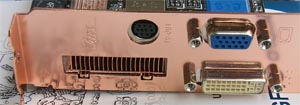 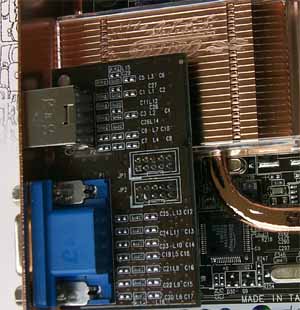 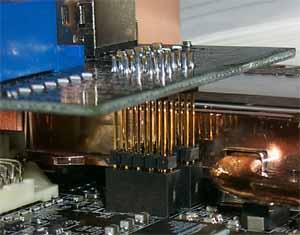 Let's take off this bulky cooler 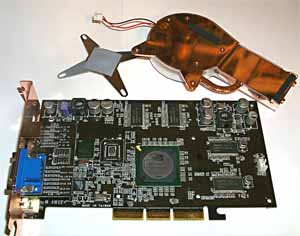 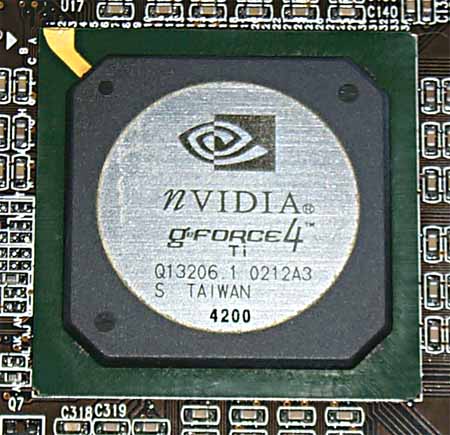 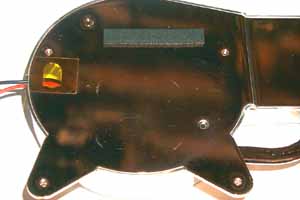 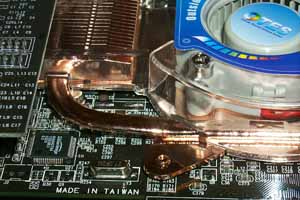 Thus, the cooling system is located not above the chip but aside. An air flow carries out the heat outside the system unit which is then exhausted through a hole in the lower part of the bracket. Hence the name of OTES: Outside Thermal Exhaust System. Such a complicated construction needs good fastening: 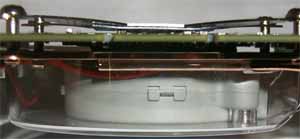 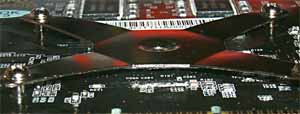 I decided to try such a cooling method and measured the chip's temperature with an external thermo sensor which is traditionally delivered with certain boards: 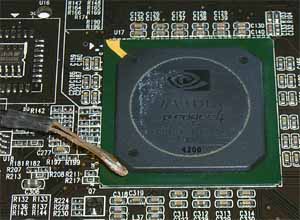 And now we are turning to the cooling devices:
|
|||||||||||||||||||||||||||||||||||||||||||||
| Both cards possess a TV-out which is based on the Philips 7104 on the
ABIT's card and on the Conexant on the ASUS's card.
Here is the stuff coming with the cards:
|
| The video cards ship in retail packages. |
That's all about peculiarities of the cards.
| ABIT Siluro GF4 Ti4200 OTES | 275/550 -> 320/626 MHz, a very good overclocking potential for the Ti 4200. OTES works! :-) |
| ASUS V8420S 128MB | 260/550 -> 310/685 MHz, not bad for the chip, but seems to be quite weak for the memory. The 3.3ns chips could easily work at 700 MHz and higher. |
Note:

Testbeds:
In the tests we used NVIDIA's drivers of v40.41. VSync was off, S3TC was off in the applications.
Before we start examining 2D quality I should say that there is no a complete technique of objective estimation of this parameter because:
| ABIT Siluro GF4 Ti4200 OTES | 1600x1200x75Hz, 1280x1024x120Hz, 1024x768x160Hz |
| ASUS V8420S 128MB | 1600x1200x85Hz, 1280x1024x120Hz, 1024x768x160Hz |
The OTES is very efficient, but its noise level might outweigh its advantages.
Such cards were tested infinite number of times and their scores and diagrams can be found in our 3Digest. Note that the ABIT Siluro GF4 Ti4200 OTES was as fast as the GeForce4 Ti 4400 though the ABIT had 64MB instead of 128.
For the performance estimation we used:
The overclocked cards are marked with red color, the sign o/c (overclocked) is followed by the frequencies reached.
Highs:
Write a comment below. No registration needed!
|
Article navigation: |
| blog comments powered by Disqus |
| Most Popular Reviews | More RSS |
 |
Comparing old, cheap solutions from AMD with new, budget offerings from Intel.
February 1, 2013 · Processor Roundups |
 |
Inno3D GeForce GTX 670 iChill, Inno3D GeForce GTX 660 Ti Graphics Cards A couple of mid-range adapters with original cooling systems.
January 30, 2013 · Video cards: NVIDIA GPUs |
 |
Creative Sound Blaster X-Fi Surround 5.1 An external X-Fi solution in tests.
September 9, 2008 · Sound Cards |
 |
The first worthwhile Piledriver CPU.
September 11, 2012 · Processors: AMD |
 |
Consumed Power, Energy Consumption: Ivy Bridge vs. Sandy Bridge Trying out the new method.
September 18, 2012 · Processors: Intel |
| Latest Reviews | More RSS |
 |
Retested all graphics cards with the new drivers.
Oct 18, 2013 · 3Digests
|
 |
Added new benchmarks: BioShock Infinite and Metro: Last Light.
Sep 06, 2013 · 3Digests
|
 |
Added the test results of NVIDIA GeForce GTX 760 and AMD Radeon HD 7730.
Aug 05, 2013 · 3Digests
|
 |
Gainward GeForce GTX 650 Ti BOOST 2GB Golden Sample Graphics Card An excellent hybrid of GeForce GTX 650 Ti and GeForce GTX 660.
Jun 24, 2013 · Video cards: NVIDIA GPUs
|
 |
Added the test results of NVIDIA GeForce GTX 770/780.
Jun 03, 2013 · 3Digests
|
| Latest News | More RSS |
Platform · Video · Multimedia · Mobile · Other || About us & Privacy policy · Twitter · Facebook
Copyright © Byrds Research & Publishing, Ltd., 1997–2011. All rights reserved.